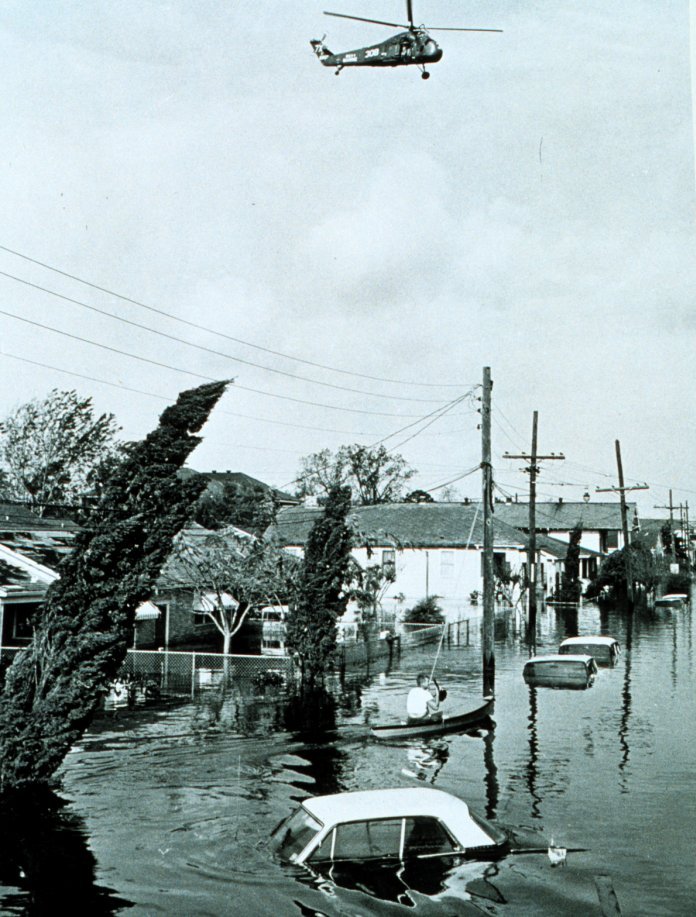
1. Introduction
In this essay we will address the popular claim that man-made global warming is leading to more frequent, and more powerful tropical cyclones, e.g., hurricanes, typhoons and other heavy tropical storms. We will show that this claim is invalid, and is based on an incomplete, and inadequate analysis of the data.
Before we do so, it may be helpful to briefly summarise some of the basic facts and figures on tropical storms.
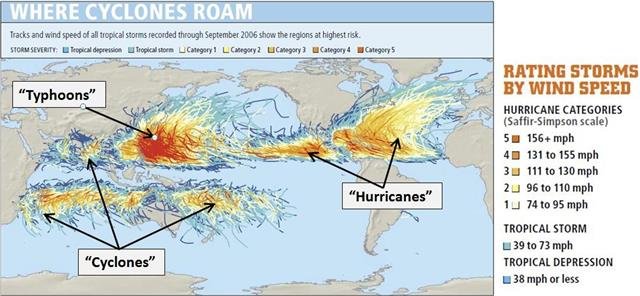
Every year, during the summer/autumn, about 80-90 tropical storms form over the oceans. About 40-50 of these become strong enough to be classed as “tropical cyclones”. Depending on where a tropical cyclone forms, it can have a different name. Tropical cyclones which form in the North Atlantic or east Pacific oceans are known as “hurricanes”. If they form in the west Pacific, they are known as “typhoons”, while if they form in one of the other ocean basins, they are known as “cyclones” – see Figure 1.
Most of these tropical cyclones die out while they’re still out at sea, but maybe 10-20 of them will strike land.
To distinguish between different strengths of tropical cyclones, meteorologists usually use the “Saffir-Simpson hurricane scale”, even though this scale was originally just devised for describing “hurricanes”. In the Saffir-Simpson scale, cyclones are classified based on their maximum sustained wind speeds, as follows:
- “Tropical depression” = wind speeds less than 17 m/s (38 mph or 62 km/h)
- “Tropical storm” = wind speeds less than 32 m/s (73 mph or 118 km/h)
- Category 1 = wind speeds less than 42 m/s (95 mph or 153 km/h)
- Category 2 = wind speeds less than 49 m/s (110 mph or 177 km/h)
- Category 3 = wind speeds less than 58 m/s (129 mph or 208 km/h)
- Category 4 = wind speeds less than 70 m/s (157 mph or 251 km/h)
- Category 5 = wind speeds of at least 70 m/s (157 mph or 251 km/h)
When a tropical cyclone strikes land, its effects can be devastating for those who live in (or near) its path. There are three features of a tropical cyclone which are particularly devastating:
- Very high wind speeds
- Storm surges
- Heavy rainfall and thunderstorms

For this reason, when a major cyclone makes landfall, its effects are often disastrous, and it is global news. However, in recent years, a popular perception seems to have arisen that man-made global warming is causing more frequent and more intense cyclones to occur. As a result, nowadays, whenever a cyclone makes landfall, people have taken to blaming it on our fossil fuel usage.
For instance, after storm surges from Hurricane Sandy caused extensive damage to New York City, NY (USA) in October 2012, it convinced the Mayor of New York City, Mike Bloomberg that man-made global warming is real and that we should immediately reduce our carbon dioxide emissions:
Our climate is changing. And while the increase in extreme weather we have experienced in New York City and around the world may or may not be the result of it, the risk that it might be — given this week’s devastation — should compel all elected leaders to take immediate action. – Mike Bloomberg, 1st November 2012
As another example, U.K. Prime Minister, David Cameron, has claimed that the November 2013 Typhoon Haiyan, which caused catastrophic destruction to the central Philippines was related to man-made global warming:
There is growing evidence that climate change is linked to severe weather events such as the typhoon in the Philippines – David Cameron, 16th November 2013
Although the devastation Typhoon Haiyan caused in the Philippines was horrendous, there does not appear to have been any long term trend in the number of tropical cyclones reaching the Philippines, e.g., see Kubota & Chan, 2009 (Abstract; Google Scholar access). Some of the initial media reports and blog commentary of Typhoon Haiyan suggested that it was “…an unnaturally powerful storm… [which]…exhibited characteristics outside the range of natural variation.” and that it was so strong we might need a new hurricane category. However, this seems to have been just sensationalism and over-hype – the typhoon seems to have been a very strong storm, but was definitely not the strongest, e.g., see here, here, or here.
So, why do so many people believe that humans are causing an increase in cyclone activity, and that our fossil fuel usage is somehow to blame for these natural disasters?
In Section 2, we will discuss how the notion arose. Then in Sections 3-6, we will show how it is an invalid notion, which is based on an incomplete and inadequate analysis of the data.
2. The 2005 “hurricane wars” debate
A. The proposed link between global warming and tropical cyclones
Tropical cyclones are known to form over warm ocean waters, with Sea Surface Temperatures (SST) generally being at least 26°C (80°F) before they form, e.g., see here.
This apparent link has led some researchers to propose that the intensity of a tropical cyclone depends on the temperature of the oceans over which it forms. According to this theory, if the tropical oceans heat up, this should mean more frequent and more intense tropical cyclones. The corollary of the theory is that if the tropical oceans cool down that would mean a reduction in cyclonic activity.
It is important to stress that this is only a theory, and despite on-going research, we still don’t know exactly how and why tropical cyclones form and what decides their intensity – the technical term for this subject is “tropical cyclogenesis”. See Knutson et al., 2010 (Abstract; Google Scholar access) for a recent review.
Indeed, in one of our papers, we identify a new mechanism which suggests that the main driver in cyclone formation is a rapid change in the altitude at which “multimerization” occurs, and not the ocean temperatures – see this essay for more information on this.

Nonetheless, the theory that cyclone intensity is related to ocean temperatures is quite popular among the tropical cyclone scientific community.
If the theory is correct, and warmer ocean temperatures cause more intense and more frequent tropical cyclones, then global warming should cause an increase in cyclone activity.
B. The debate
In the 1990s, this theory was the subject of some debate, and there didn’t seem to be any conclusive evidence one way or the other. While computer models suggested that global warming should cause an increase in cyclone intensity, e.g., Evans et al., 1994 (Open access), the historical data showed no obvious link between the intensity of a tropical cyclone and the temperatures where it formed, e.g., Evans, 1993 (Open access).
This all changed in the mid-2000s, when several researchers began publishing papers claiming to have finally discovered evidence proving that man-made global warming was increasing the frequency and intensity of tropical cyclones, e.g., Trenberth, 2005 (Abstract; Google Scholar access); Emmanuel, 2005 (Abstract; Google Scholar access); Webster et al., 2005 (Abstract; Google Scholar access); Trenberth & Shea, 2006 (Abstract; Google Scholar access); Mann & Emanuel, 2006 (Abstract; Google Scholar access); or Holland & Webster, 2007 (Open access).
Coincidentally, 2004 and 2005 marked the peak of a very active period for tropical cyclones which had begun in the mid-1990s. When Hurricane Katrina devastated the U.S. city of New Orleans in August 2005, this was compelling confirmation for many people that we were seeing unusual changes in the weather, and that this was due to man-made global warming:
However, while a lot of researchers were convinced that they had found compelling evidence for a man-made global warming “signal” in the tropical cyclone trends, there were also a lot of researchers who strongly disagreed.
As a result, the claim that man-made global warming was causing an increase in hurricane activity was very controversial, and it led to a bitter divide amongst scientists studying cyclones. Two camps formed, with one arguing that the 1995-2005 period of high cyclone activity was just part of natural variability, and the other arguing that it was due to man-made global warming.
The controversy became quite vicious and personal, with both camps considering the other camp completely wrong. For example, see Pielke et al., 2005 (Open access), the response by Anthes et al., 2006 (Open access) and the reply by Pielke et al., 2006 (Open access)
Dr. Chris Landsea (a supporter of the natural variability explanation), even resigned in January 2005 as a contributing author to the Intergovernmental Panel on Climate Change (IPCC), after the co-ordinating lead author for his section, Dr. Kevin Trenberth (a supporter of the man-made global warming explanation) held a press conference, implying that the IPCC considered the high hurricane activity of 2004 to be related to man-made global warming.
The dispute came to a head when it made headlines in the Wall Street Journal on 2nd February 2006 (Paywall access; Alternative link on Post-Gazette.com). According to Prof. Judith Curry (a co-author of Webster et al., 2005), this prompted a truce between the two opposing camps – see here.
Since then, while debate continues between the two camps, it has been much more civil, with researchers on both sides conceding the data is problematic, and that it is probably too uncertain to establish conclusively whether the cyclonic activity of the 1990s and 2000s were unusual or not. See for example the recent Knutson et al., 2010 review (Abstract; Google Scholar access), which involved collaboration between members from both camps.
In the next sections, we will summarise the main problems with the data.
3. Increasing economic costs of hurricanes
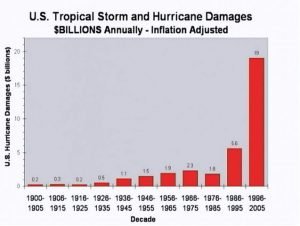
One of the pieces of data which convinced people that there had been a dramatic increase in hurricane activity was the data for the annual costs from tropical storm and hurricane damage.
Figure 4 shows the inflation-adjusted damages due to tropical storms and hurricanes in the U.S. for each decade since the start of the 20th century. Even after adjusting for inflation, the graph appears quite dramatic.
It looks like there was a dramatic increase in hurricane activity in the 1996-2005 period (and to a lesser extent in the preceding 1986-1995 period). However, this initial impression is misleading.
The problem is that hurricane damages are only an indirect measure of hurricane activity. Pielke Jr. et al., 2008 (Abstract; Google Scholar access) pointed out that, over the last century or so, there has been a fairly continuous increase in both (a) the number of people living in at-risk areas and (b) the average wealth per capita.
This means that when a hurricane strikes land now, it will tend to cause much more damage than it would have in the past, even if there is no change in the actual strength of the hurricanes striking land. Not only is there more property and infrastructure to damage, but the average amount of personal belongings has also increased, i.e., the number of cars, TVs, and other items which can be damaged by hurricanes is much greater now than it would have been in the early 20th century.
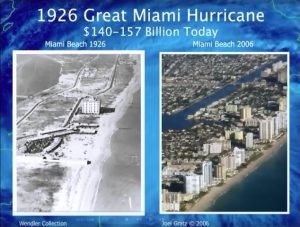
Figure 5 compares aerial photographs of Miami Beach in 1926 and 2006. In 1926, Miami Beach was struck by a Category 4 hurricane, which caused an immense amount of damage – $100 million in 1926 dollars ($1.3 billion in 2013 dollars). However, how much damage would a similar hurricane cause if it struck Miami Beach today?
Pielke et al., 2008 tried to estimate how much greater this damage would be. They decided to take the reported damages for all of the hurricanes which made landfall in the U.S. since 1900 and estimate what the damage would be if they had struck in 2005 instead. This is not an easy thing to do, and it involves making a lot of subjective decisions and assumptions.
For instance, the building materials and techniques used today have changed since the early 20th century. So, the damage a hurricane would have caused to one building built in 1926 could be different to the damage caused to an equivalent building built today. The cost of repairs might also depend on how strong the economy was at the time of the hurricane strike, e.g., if there was a shortage of labour and/or materials, this could increase costs.

Nonetheless, it is clear that if a hurricane strikes a densely populated area, this will cause more damage than a hurricane striking an isolated coast – see Figure 6. Similarly, if the average wealth of the people living in the area increases, that will generally increase the value and amount of the belongings which are damaged.
When Pielke et al., 2008 “normalized” the reported damages for the 1926 Great Miami Hurricane to account for the increases in population, numbers of housing units and average wealth per person, they calculated that it would probably have cost about $150 billion damage if it struck in 2005. This is more than 100 times as much damage as the 1926 hurricane actually caused!
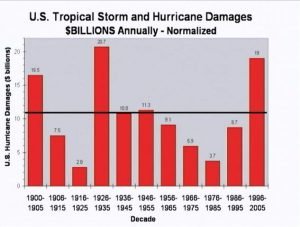
Figure 7 shows what happens to the data we saw earlier in Figure 3, after Pielke et al., 2008 applied their normalization calculations.
There is still a large increase in damages from the 1976-1985 period to the 1996-2005 period. However, it is no longer that unusual, and the normalized damages actually seem to have been greatest during the 1926-1935 period. It seems that the 1976-1985 period was relatively calm, and the 1995-2005 period was relatively active, but comparable to earlier active periods such as 1900-1905 and 1926-1935.
Pielke et al., 2008’s calculations suggest that there is nothing particularly unusual about recent hurricane activity. In other words, there is no evidence that “man-made global warming” is responsible for it.
That said, however, it shows how even if there is no trend in hurricane activity, we are still likely to see dramatic increases in the damage and destruction that hurricanes cause to us in the future. Pielke et al. estimate that if trends continue into the future then, if a hurricane exactly like the 1926 Great Miami Hurricane were to occur in the 2000s, it could cause perhaps $500 billion in damage!
It is important to remember that tropical cyclones have always been devastating and destructive. For instance, the 1970 Bhola cyclone is believed to have killed between 300,000 and 500,000 when it struck Bangladesh (then East Pakistan) and West Bengal (India), and approximately 229,000 people died after Typhoon Nina (1975) caused Banqiao Dam to collapse in China. Even further back, Ribera et al., 2008 (Open access) describe a number of devastating typhoons which killed thousands of people in the Philippines during colonial times (1550-1898).
And, it is known that the village of Coringa in India has been devastated at least twice by cyclones. In the 18th century, it was a bustling port city, but in 1789 it was devastated by a cyclone, killing approximately 20,000 people. 50 years later, on 25th November 1839, an even more devastating cyclone struck, killing approximately 300,000 people, capsizing some 20,000 ships and destroying the port. The city was never rebuilt, and remains to this day a village. See here, here and here.
However, as the world’s population continues to expand, the number of people living in areas at risk from tropical cyclones will increase, and coastal areas are becoming more vulnerable. This means that the potential devastation and destruction that could be caused by tropical cyclones will get worse and worse in the future, regardless of any change in cyclone activity.

Figure 8 shows the storm paths of Hurricane Katrina (2005) and Hurricane Sandy (2012).
When Hurricane Katrina made landfall in Florida, it was a Category 1 hurricane, but it rapidly increased in intensity to Category 5 in the Gulf of Mexico. Although it then started to decrease in intensity, it was still a Category 3 hurricane when it made landfall in Lousiana. So, we can see that it was a powerful hurricane. Including the devastation it caused to New Orleans, the total property damage from Katrina has been estimated at $81 billion.
In contrast, in terms of intensity, Hurricane Sandy was actually a fairly mild hurricane! It briefly increased in intensity to a Category 3 hurricane when it made landfall at Cuba (25th October). However, it then decreased in intensity. When it reached New Jersey on 29th October its intensity was reduced to that of a Category 1 hurricane. Nonetheless, the devastation it caused to New York, New Jersey and much of the eastern U.S. coast was extensive, and it is estimated to have caused damages in excess of $68 billion. That is almost as much as Hurricane Katrina, even though Hurricane Sandy was much less intense.
This illustrates how the impact and devastation that hurricanes and other tropical storms have on society depends not only on the intensity of the storms, but on how many people are living in the areas they strike.
As the world’s population increases, and more and more people live in at-risk areas, the potential devastation of future tropical cyclones will continue to increase dramatically… regardless of whether there is any actual change in tropical cyclone activity.
So, we should be investing more resources into better adaption and response measures. We should also continue research into better tropical cyclone monitoring and prediction facilities. In this sense, we believe that our new insights into tropical cyclone formation which we discuss here, should be useful.
We should be doing this independently of whatever theories people might have about global warming. But, what about global warming – is man-made global warming causing more hurricanes?
4. We’re much better at detecting hurricanes now
One of the great improvements of hurricane science has been the dramatic advances in hurricane detection technology since the early 20th century. Modern hurricane specialists now have access to satellites, aircraft reconnaissance, radar, buoys and automated weather stations, which their counterparts in the 1930s wouldn’t have had. As a result, we are now able to detect and record many more cyclones than we could have in the past.
Dr. Chris Landsea summarises the problem in the following 2 minute clip from 2009:

Figure 9 compares the reported hurricane paths for the 2005 hurricane season to those in 1933. Both of these years were very active hurricane years. However, in 1933, almost no hurricanes were detected in the open sea, while in 2005 quite a lot of the reported hurricanes formed and dissipated before coming near land. This can be seen if you compare the numbers of hurricanes in the red circles in Figure 9.
In the 1930s, meteorologists didn’t have the technology to properly monitor hurricanes in the open sea. So, it is likely that many hurricanes which would be detected with modern technology and techniques would never have been reported.
By comparing the more complete modern data for cyclone distributions to the shipping routes used in the early 20th century, Vecchi & Knutson, 2008 (Open access) have calculated rough estimates for the numbers of missed cyclones in the pre-satellite era. They estimate that an average of 3-4 storms a year were being missed in the late 19th century, and that even by 1950s and 1960s, probably 2-3 storms a decade were going undetected because of incomplete monitoring.
Even after applying these adjustments, Landsea et al., 2010 (Open access) noticed that there was still an anomalous “trend” in the number of very short storms being reported. They found no obvious trend in the frequency of reported large storms that lasted several days, but they did find a dramatic increase in the number of recorded storms that were very short, and lasted less than 2 days.
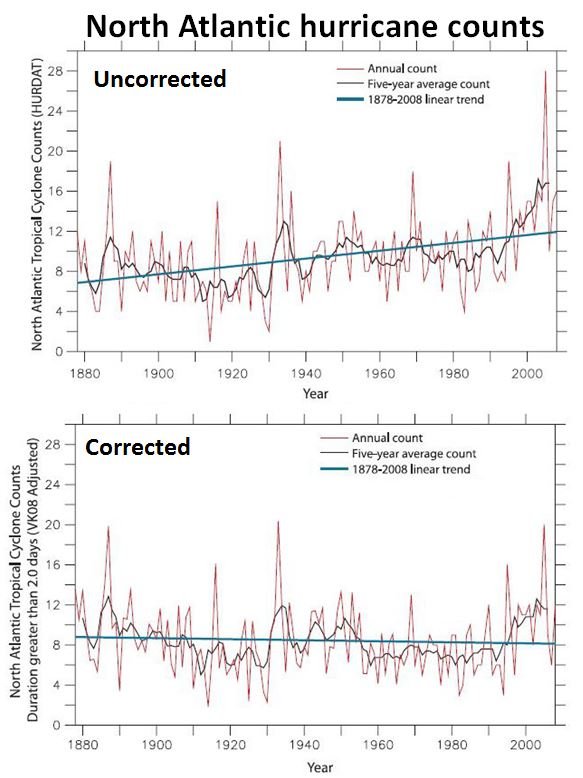
This suggests that our ability to detect very short and weak storms before they dissipate has dramatically improved. With this in mind, Landsea et al., 2010 suggested that, if we want to look for the true trends in hurricane activity, we should first remove these short-lived cyclones that would have been hard to detect without satellite technology.
The top panel of Figure 10 shows the uncorrected dataset for reported North Atlantic hurricanes. The bottom panel shows the same dataset after including Vecci & Knutson, 2008’s estimates for the missing storms, and Landsea et al., 2010’s recommendation to subtract all of the very short-lived storms.
In the uncorrected dataset, there seems to have been a long-term increase in hurricane activity. The counts from about 1995 to 2005 seem especially high. This partly explains why in the mid-2000s, some researchers thought that they were detecting unusual increases.
However, when the corrections are applied, this trend disappears. The hurricane activity of the 1995-2005 period still seems to have been above average, but there also seem to have been similar active periods in the late 19th century and mid-20th century.
The above discussion only refers to tropical cyclones formed in the North Atlantic basin. Having said that, similar changes in tropical cyclone detection also seem to have occurred for each of the other basins, e.g., Hoarau et al., 2012 (Abstract) suggest that incomplete satellite coverage during the 1980s and early 1990s led to an underestimation of cyclone intensity in the northern Indian Ocean basin.
In other words, many of the apparent “trends” in tropical cyclone frequency and intensity are probably artefacts of the changes in detection and monitoring technology.
We might never know for sure how many cyclones were missed as a result of the limitations of the older technology. Estimating the “missing cyclones” is always going to be a somewhat subjective process. As a result, there has been considerable debate and disagreement over exactly how many tropical cyclones we missed in the earlier parts of the records, e.g., compare Landsea, 2007 (Abstract; Google Scholar access); Mann et al., 2007 (Abstract; Google Scholar access); Holland, 2007 (Abstract; Google Scholar access); Vecchi & Knutson, 2008 (Open access); and Landsea et al., 2010 (Open access). However, it is now widely agreed that at least some of the cyclone “trends” discovered in the mid-2000s were spurious artefacts.
It is good that our ability to monitor and detect tropical storms is improving, and we should continue doing so. However, we need to be very careful not to mistakenly treat these higher detection rates as indicating a real trend in cyclone activity.
5. No long-term trends in the current data

One way to bypass the problems caused by the improvements in storm monitoring is to only focus on tropical cyclones which strike land. If a tropical cyclone strikes a well-populated area, it is going to be noticed. As a result, the records of landfalling tropical cyclones are probably fairly complete, when available. The landfalling cyclones are also of more importance to society, since they are the ones which have the biggest impact on us.
Weinkle et al., 2012 (Abstract; Google Scholar access provide a database for the recorded landfalling tropical cyclones for each of the main ocean basins (data available from Prof. Pielke Jr.’s website). Figure 11 shows the trends for each of these basins for both major (Categories 3, 4 or 5) and minor (Categories 1 or 2) tropical cyclones.
In none of the basins does there seem to be any long-term trend.
For the North Atlantic basin, 2005 does seem to have been a very active year, and there did seem to have been an increasing trend starting in the mid-1990s. However, after all the claims that man-made global warming was responsible for 2005 being unusually active, 2006 was unusually quiet and no hurricanes made landfall!
At the time, some researchers claimed that this was probably just a temporary “lull”, and that global warming would kick back with a vengeance in the following years, e.g., Trenberth, 2007 (Abstract; Google Scholar access). This doesn’t seem to have happened. Indeed, Prof. Roger Pielke, Jr. has calculated that, even if a major hurricane makes landfall in the US during the 2014 hurricane season, it will still be the longest period on record without a hurricane of Category 3+ making landfall in the US! See here for an analysis.

Figure 12 shows the total numbers for all basins. The figure only covers the period with data for all basins, and most of the basins only have records going back to 1970. So, this only tells us of the 1970-2010 period, but there do not seem to be any substantial long-term trends.
The 1990s and 2000s do seem to have had a larger number of major tropical cyclones than the 1970s and 1980s, but we can see from the longer records in Figure 11 (i.e., North Atlantic and West Pacific) that the 1970s were a fairly quiet era. So, this seems to be within the bounds of the natural variability from decade to decade. Also, the last few years seem to have been relatively quiet. Prof. Roger Pielke, Jr. has recently updated this dataset to 2013 (see here), and the trends remain fairly similar.
Liu et al., 2001 (Abstract; Google Scholar access) looked through a large historical collection of local newspapers stretching back to 975 AD (Fang Zhi) for the Guangdong Province of southern China for reports of any major typhoons. Obviously, whenever a major typhoon hit the area, it was an important news event, just like it is today. So, Liu et al. were able to find records for 571 major typhoon strikes.
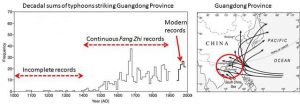
Figure 13 shows the total number of typhoons recorded in the Fang Zhi for each decade from 1000 AD up to the end of the 19th century. Before the 1400s, the newspaper collection was quite scattered and incomplete, and so many of the typhoons which would have struck are probably missing, but there is a continuous record from about the 15th century up to the early 20th century. When Liu et al. compared their estimates to the decadal sums from the modern record for the late 20th century, they found that the recent typhoon activity for the area was quite normal.

Kubota & Chan, 2009 (Abstract; Google Scholar access) studied typhoon landfalls for the neighbouring region of the Philippines. Figure 14 shows the annual typhoon landfall numbers for the Philippines from 1902-2005, using three different datasets.
While we can see that the average number of typhoons varies from decade to decade, there does not seem to have been any long-term trend in typhoons hitting the Philippines.
By carefully analysing historical documents, it may be possible to extend our limited tropical cyclone records back in time. This is an on-going subject of research in the hurricane field, e.g., Ribera et al., 2008 (Open access) and Grossman & Zaiki, 2009 (Open access), and the North Atlantic Hurricane Database Re-analysis Project.
Still, in any case, in terms of landfalling tropical cyclones, there does not seem to be any long-term trend in the available data.
6. Current views on the proposed link between global warming and hurricanes
As we discussed in Section 2, in the early 2000s, a lot of researchers were arguing that they had found a man-made global warming “signal” in the hurricane and tropical cyclone data. However, there has been a noticeable shift in the last few years amongst the tropical cyclone specialist community, and this view is no longer widely-held.
Many tropical cyclone specialists still believe that man-made global warming is occurring. But, there now seems to be a general agreement that the apparent signals that had been reported in the 2000s were biased by the various factors described in the previous sections, and that trends of the last few decades are within the bounds of natural variability, e.g., see the Knutson et al., 2010 review (Abstract; Google Scholar access).
It is now generally agreed that the proposed link between global warming and hurricane activity is not as straightforward as had been originally thought.
It is still widely believed that tropical cyclone formation requires warm ocean temperatures. So, if global warming were to cause a substantial heating of the tropical oceans, many researchers believe this will have an effect on tropical cyclone activity in the future. But, it is not clear exactly what those effects these might be, and when they would become significant, e.g., see the Knutson et al., 2010 review mentioned above.
It is true that some researchers still believe that these effects are already detectable, e.g., Holland & Bruyère, 2013 (Open access) or Mann et al., 2009 (Abstract; Google Scholar access). But, others now believe it will take several decades before these effects would become statistically significant.
There is disagreement over exactly how long it would take before a man-made global warming signal would become significant. For instance, Emanuel, 2011 (Abstract; Google Scholar access) suggests that a global warming signal could become statistical significant sometime over the next century or two, and that there could be some indications on time scales as short as 25 years. In contrast, Crompton et al., 2011 (Open access) suggest that it would probably take several centuries before a man-made global warming signal would become large enough to be detectable.
Of course, we argue elsewhere that man-made global warming theory is invalid (see our Start here page for more details), and that carbon dioxide (CO2) increases have no effect on atmospheric temperatures, let alone ocean temperatures. Therefore, we disagree that there would ever be a “man-made global warming”-induced increase in tropical cyclone activity.
Moreover, in our “Physics of the Earth’s atmosphere” Paper 2, we suggest that tropical cyclones are formed when the altitude at which “multimerization” occurs changes rapidly – see this essay for an overview. So, it is possible that the formation of tropical cyclones might have nothing to do with the temperature of the oceans! The apparent link between tropical cyclone formation and ocean temperatures might just be a coincidence.
Indeed, Hoarau et al., 2012 (Abstract)failed to find any link between cyclone intensity and sea surface temperatures in the north Indian Ocean. Similarly, as we mentioned in Section 2, Evans, 1993 (Open access) was unable to find any obvious link in the historical data between the intensity of a tropical cyclone and the temperatures where it formed.
7. Conclusions
Some recent tropical cyclones such as Hurricane Katrina (2005), Hurricane Sandy (2012) and Typhoon Haiyan (2013) have received a lot of media coverage due to the tragic destruction and devastation they caused when they struck land. Cyclone Nargis (2008) was particularly disastrous and led to nearly 140,000 deaths after it made landfall in Myanmar.
In the mid-2000s, a number of researchers claimed that man-made global warming was causing a noticeable increase in the frequency and intensity of tropical cyclones. This claim seems to have contributed to the popular perception that our fossil fuel usage is causing “more extreme weather”, e.g., see here, here or here.
After considerable debate over the last few years, many of those researchers have agreed that the data is a lot more ambiguous than they had originally thought. Some of these researchers still claim that man-made global warming will eventually cause a noticeable increase in tropical cyclone activity, but not for several more decades, at least. In other words, there is currently no unusual trends in the data.
For instance, in 2012, the Intergovernmental Panel on Climate Change (IPCC) issued a special report studying links between climate change and extreme weather, titled “Managing the risks of extreme events and disasters to advance climate change adaption”. As we discuss in our “What does the IPCC say?” essay, many people regard the IPCC reports as being representative of the “scientific consensus” on climate change. So, it is instructive to note what they concluded on tropical cyclones.
Whether they looked at intensity, frequency or duration, they couldn’t find any long-term increase in tropical cyclone activity:
There is low confidence in any observed long-term (i.e., 40 years or more) increases in tropical cyclone activity (i.e., intensity, frequency, duration), after accounting for past changes in observing capabilities. – IPCC, “Climate extremes and impacts”, p8, Summary for Policymakers, Special Report (2012)
Having said that, the IPCC did find that:
Economic losses from weather- and climate-related disasters have increased… – IPCC, “Disaster losses”, p9, Summary for Policymakers, Special Report (2012)
As the world’s population has increased, the number of people living in coastal areas at risk from tropical cyclones has increased. This means that the devastation and destruction that tropical cyclones are causing is increasing.
Presumably, this will get worse and worse in the future, as the population continues to increase, regardless of any change in cyclone activity. This has nothing to do with man-made global warming.
Reducing our “carbon footprint” will do absolutely nothing to help people living in at-risk coastal regions. Instead, we should be investing in better tropical cyclone detection, prediction and response measures.
With this in mind, our new insights into tropical cyclone formation that we discuss in our “Physics of the Earth’s atmosphere” Paper 2 (see here for a summary) should be useful in improving cyclone prediction.

Excellent article. Well researched, well written. I shall be linking to it frequently.
Oh yes it does, and it does a lot.
Our activity here on Earth produces all the weather anomalies which some skeptics try to blame the volcanoes or the Sun for it.
But no, they are not guilty here, we are those to blame.
If our polluting activities have nothing to do with the hurricanes than why France’s President Francois Hollande during its recent visit in the Philippines called for more actions in order to stop climate change because he said that Typhoon Hagupit and Typhoon Hayan which devastated the region become that big and dangerous due to our polluting activities which brings the planet on the brink of disaster.
http://www.alternative-energies.net/frances-president-francois-hollande-calls-for-more-actions-to-stop-climate-change/
Hi Jane Girl,
Thank you for your comment, but can I ask, is there a particular part of our analysis of the debate over hurricane (& tropical cyclone) trends that you disagree with? If so, could you highlight which section(s) you have a problem with, and why?
With regards to President Hollande’s statements, did you see we already included in Section 1 examples of two other politicians who had made similar statements? i.e., former Mayor of New York, Mike Bloomberg speaking on Hurricane Sandy & UK Prime Minister, David Cameron speaking on Typhoon Haiyan. Do you feel that Hollande’s statement makes some relevant point(s) which our discussion in Section 1 of Bloomberg & Cameron’s statements didn’t address?